Etruscan Fine Ware Pottery: Near-Infrared (NIR) Spectroscopy as a Tool for the Investigation of Clay Firing Temperature and Atmosphere
Abstract
:1. Introduction
2. Materials and Methods
2.1. Archaeological Ceramic Samples from Tarquinia
2.2. Test Samples of Clay from Tarquinia and Heating Experiments
2.3. NIR Analysis
2.4. FTIR Analysis
2.5. XRD Analysis
2.6. Mathematical Treatment and Multivariate Analysis of Spectral Data
2.6.1. PCA of NIR Spectra
2.6.2. PLS Model Based on FTIR Spectra
3. Results and Discussion
3.1. Diffuse Reflectance NIR Spectra of Fired Tarquinia Clay
- 1410 nm 2νOH and ν’w + 2δw
- 1910 nm ν’w + δw
- 1966 nm νw + 2δw
- 2210 nm νOH + δAl-OH
- 2342 nm νOH + δMg-OH
3.2. Diffuse Reflectance NIR Spectra of Archaeological Ceramic Samples from the Civita di Tarquinia
3.3. Mineralogical Composition of the Archaeological Samples from the Civita di Tarquinia: Semi-Quantitative Analysis Based on FTIR Spectra and Comparison with XRD Data
3.4. Diffuse Reflectance Visible-NIR Spectra of Archaeological Ceramic Samples from the Civita di Tarquinia
4. Conclusions
Supplementary Materials
Funding
Informed Consent Statement
Data Availability Statement
Conflicts of Interest
References
- Tite, M.S. Ceramic production, provenance and use—A review. Archaeometry 2008, 50, 216–231. [Google Scholar] [CrossRef]
- Tite, M.S. Determination of the firing temperature of ancient ceramics by measurement of thermal expansion: A reassessment. Archaeometry 1969, 11, 131–143. [Google Scholar] [CrossRef]
- Heimann, R.; Franklin, U.M. Archaeo-thermometry: The assessment of firing temperatures of ancient ceramics. J. Int. Inst. Conserv.-Can. Group 1979, 4, 23–45. [Google Scholar]
- Palmiter, T.; Johnson, P. Techniques for archaeothermometry. MRS Proc. 1988, 123, 135–140. [Google Scholar] [CrossRef]
- Tite, M.S. Firing Temperature Determination: How and Why? In The Aim of Laboratory Analysis in Archaeology; KVHAA Konferenser 34; Lindahl, A., Stilberg, O., Eds.; Kungl. Vitterhets Historie och Antikvitets Akademien: Stockholm, Sweden, 1995; pp. 37–42. [Google Scholar]
- Holakooei, P.; Tessari, U.; Verde, M.; Vaccaro, C. A new look at XRD patterns of archaeological ceramic bodies. J. Therm. Anal. Calorim. 2014, 118, 165–176. [Google Scholar] [CrossRef]
- Maritan, L.; Holakooei, P.; Mazzoli, C. Cluster analysis of XRPD data in ancient ceramics: What for? Appl. Clay Sci. 2015, 114, 540–549. [Google Scholar] [CrossRef]
- Mangueira, G.M.; Toledo, R.; Teixeira, S.; Franco, R.W.A. A study of the firing temperature of archeological pottery by X-ray diffraction and electron paramagnetic resonance. J. Phys. Chem. Solids 2011, 72, 90–96. [Google Scholar] [CrossRef]
- Maritan, L.; Mazzoli, C.; Freestone, I. Modelling changes in mollusc shell internal microstructure during firing: Implications for temperature estimation in shell-bearing pottery. Archaeometry 2007, 49, 529–541. [Google Scholar] [CrossRef]
- Maggetti, M.; Galetti, G. Archäometrische Untersuchungen an spätlateinezeitlicher Keramik von Basel-Gasfabrik und Sissach-Brühl. Archäologisches Korresp. 1981, 11, 321–328. [Google Scholar]
- Nodari, L.; Marcuz, E.; Maritan, L.; Mazzoli, C.; Russo, U. Hematite nucleation and growth in the firing of carbonate-rich clay for pottery production. J. Eur. Ceram. Soc. 2007, 27, 4665–4673. [Google Scholar] [CrossRef]
- Maritan, L.; Nodari, L.; Mazzoli, C.; Milano, A.; Russo, U. Influence of firing conditions on ceramic products: Experimental study on clay rich in organic matter. Appl. Clay Sci. 2006, 31, 1–15. [Google Scholar] [CrossRef]
- Maggetti, M.; Galetti, G.; Schwander, H.; Picon, M.; Wessicken, R. Campanian pottery; the nature of the black coating. Archaeometry 1981, 23, 199–207. [Google Scholar] [CrossRef]
- Bruni, S.; Guglielmi, V.; Della Foglia, E.; Castoldi, M.; Bagnasco Gianni, G. A non-destructive spectroscopic study of the decoration of archaeological pottery: From matt-painted bichrome ceramic sherds (southern Italy, VIII–VII B.C.) to an intact Etruscan cinerary urn. Spectrochim. Acta A 2018, 191, 88–97. [Google Scholar] [CrossRef] [PubMed] [Green Version]
- Stevenson, C.M.; Gurnick, M. Structural collapse in kaolinite, montmorillonite and illite clay and its role in the ceramic rehydroxylation dating of low-fired earthenware. J. Archaeol. Sci. 2016, 69, 54–63. [Google Scholar] [CrossRef] [Green Version]
- Cariati, F.; Bruni, S.; Fermo, P. Indagini chimico-fisiche sulla ceramica depurata e di impasto. In Tarquinia Scavi Sistematici Nell’abitato. Campagne 1982–1988. I Materiali 2; Bonghi Jovino, M., Ed.; L’Erma di Bretschneider: Roma, Italy, 2001; pp. 525–536. [Google Scholar]
- Ispra: Carta Geologica D’Italia 1:50000-354 Tarquinia. Available online: https://www.isprambiente.gov.it/Media/carg/354_TARQUINIA/Foglio.html (accessed on 27 February 2022).
- Wold, H. Soft Modeling by Latent Variables: The Nonlinear Iterative Partial Least Squares Approach. In Perspectives in Probability and Statistics, Papers in Honour of M.S. Bartlett; Gani, J., Ed.; Academic Press: London, UK, 1975; pp. 117–142. [Google Scholar]
- Heimann, R.B. Assessing the technology of ancient pottery: The use of ceramic phase diagrams. Archeomaterials 1989, 3, 123–148. [Google Scholar]
- Heimann, R.B.; Maggetti, M. Experiments on simulated burial of calcareous terra sigillata (mineralogical change). Preliminary results. Br. Mus. Occas. Pap. 1981, 19, 163–177. [Google Scholar]
- Shoval, S.; Beck, P. Thermo-FTIR spectroscopy analysis as a method of characterizing ancient ceramic technology. J. Therm. Anal. Calorim. 2005, 82, 609–616. [Google Scholar] [CrossRef]
- Cheng, J.-H.; Sun, D.-W. Partial least squares regression (PLSR) applied to NIR and HIS spectral data modeling to predict chemical properties of fish muscle. Food Eng. Rev. 2017, 9, 36–49. [Google Scholar] [CrossRef]
- Bruni, S.; Cariati, F.; Bagnasco Gianni, G.; Bonghi Jovino, M.; Artioli, G.; Russo, U. Spectroscopic characterization of Etruscan depurata and impasto pottery from the excavation at Pian di Civita in Tarquinia (Italy): A comparison with local clay. In Archaeology and Clays, BAR International Series 942; Druc, I., Ed.; BAR Publishing: Oxford, UK, 2001; pp. 27–38. [Google Scholar]
- Chanéac, C.; Tronc, E.; Jolivet, J.P. Magnetic iron oxide–silica nanocomposites. Synthesis and characterization. J. Mater. Chem. 1996, 6, 1905–1911. [Google Scholar] [CrossRef]
- Cariati, F.; Erre, L.; Micera, G.; Piu, P.; Gessa, C. Water molecules and hydroxyl groups in montmorillonites as studied by near infrared spectroscopy. Clays Clay Miner. 1981, 29, 157–159. [Google Scholar] [CrossRef]
- Cariati, F.; Erre, L.; Micera, G.; Piu, P.; Gessa, C. Effects of layer charge on the near-infrared spectra of water molecules in smectites and vermiculites. Clays Clay Miner. 1983, 31, 447–449. [Google Scholar] [CrossRef]
- Michael, P.J.; McWhinnie, W.R. Mössbauer and esr studies of the thermochemistry of illite and montmorillonite. Polyhedron 1989, 8, 2709–2718. [Google Scholar] [CrossRef]
- Maniatis, Y.; Katsanos, A.; Caskey, M.E. Technological examination of low-fired terracotta statues from Ayia Irini, Kea. Archaeometry 1982, 24, 191–198. [Google Scholar] [CrossRef]
- van der Marel, H.W.; Beutelspacher, H. Atlas of Infrared Spectroscopy of Clay Minerals and Their Admixtures; Elsevier: Amsterdam, The Netherlands, 1976. [Google Scholar]
- Gasden, J.A. Infrared Spectra of Minerals and Related Inorganic Compounds; Butterworths: London, UK, 1975. [Google Scholar]
- Marusak, L.A.; Messier, R.; White, W.B. Optical absorption spectrum of hematite, αFe2O3 near IR to UV. J. Phys. Chem. Solids 1980, 41, 981–984. [Google Scholar] [CrossRef]
- Lever, A.B.P. Inorganic Electronic Spectroscopy, 2nd ed.; Elsevier: Amsterdam, The Netherlands, 1984. [Google Scholar]
- Han, D.; Meng, Z.; Wu, D.; Zhang, C.; Zhu, H. Thermal properties of carbon black aqueous nanofluids for solar absorption. Nanoscale Res. Lett. 2011, 6, 457. [Google Scholar] [CrossRef] [Green Version]
- Rasmussen, T.B. Bucchero Pottery from Southern Etruria; Cambridge University Press: Cambridge, UK, 2006; p. 2. [Google Scholar]




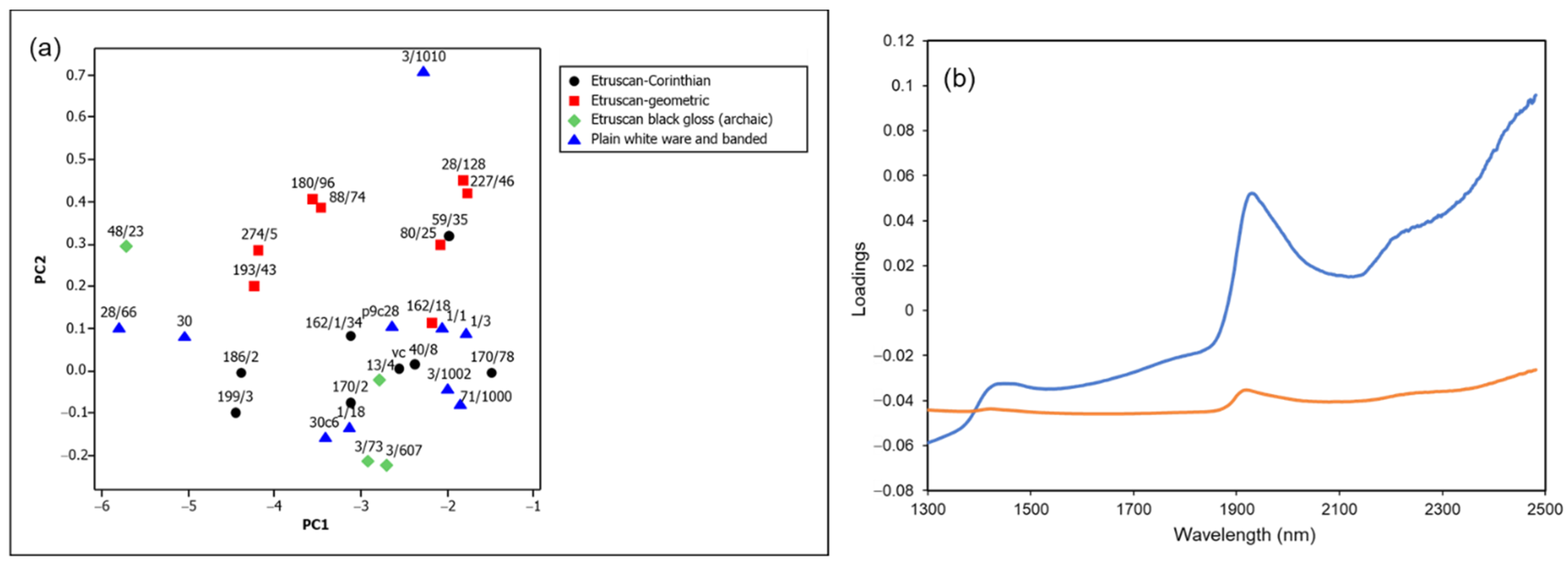
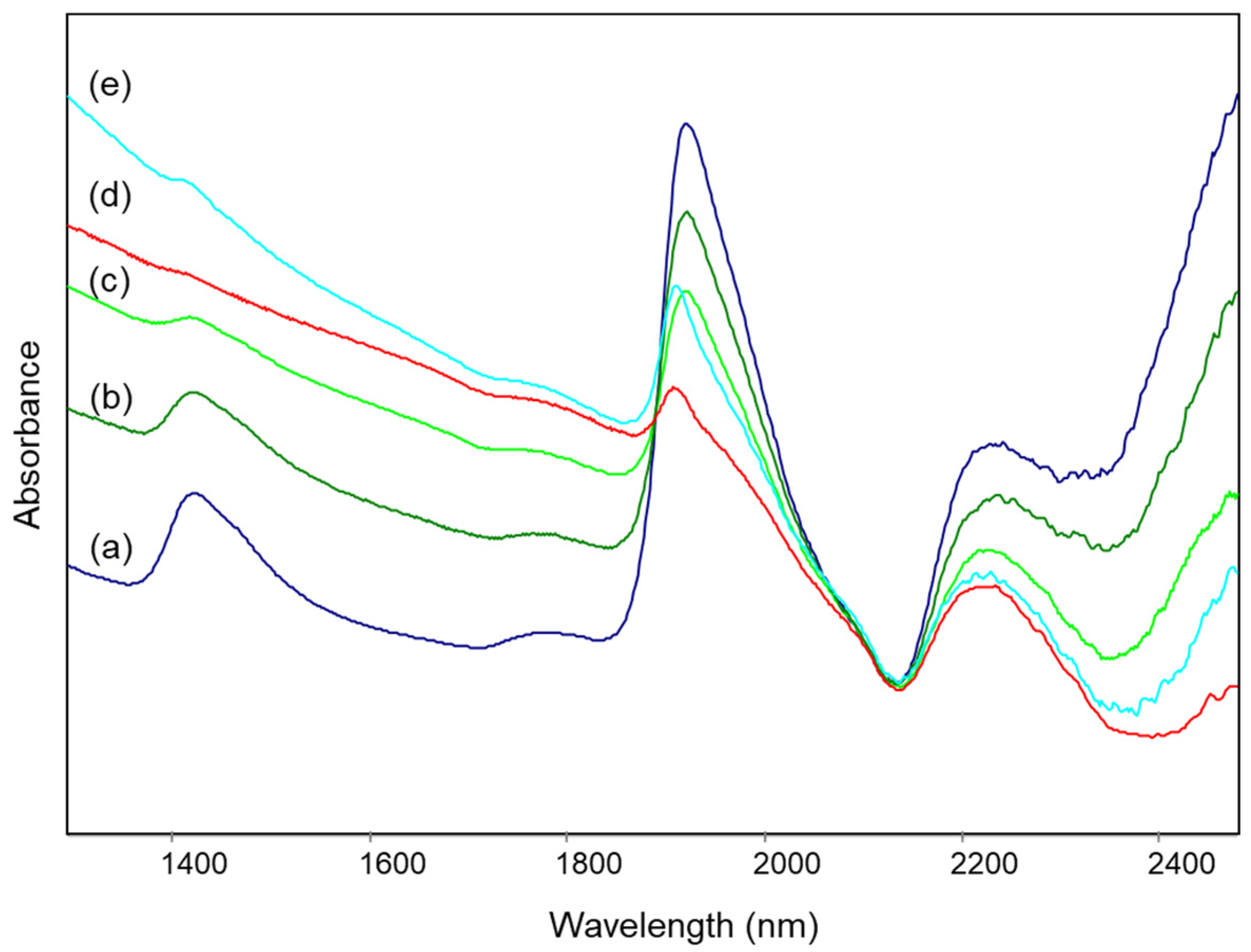
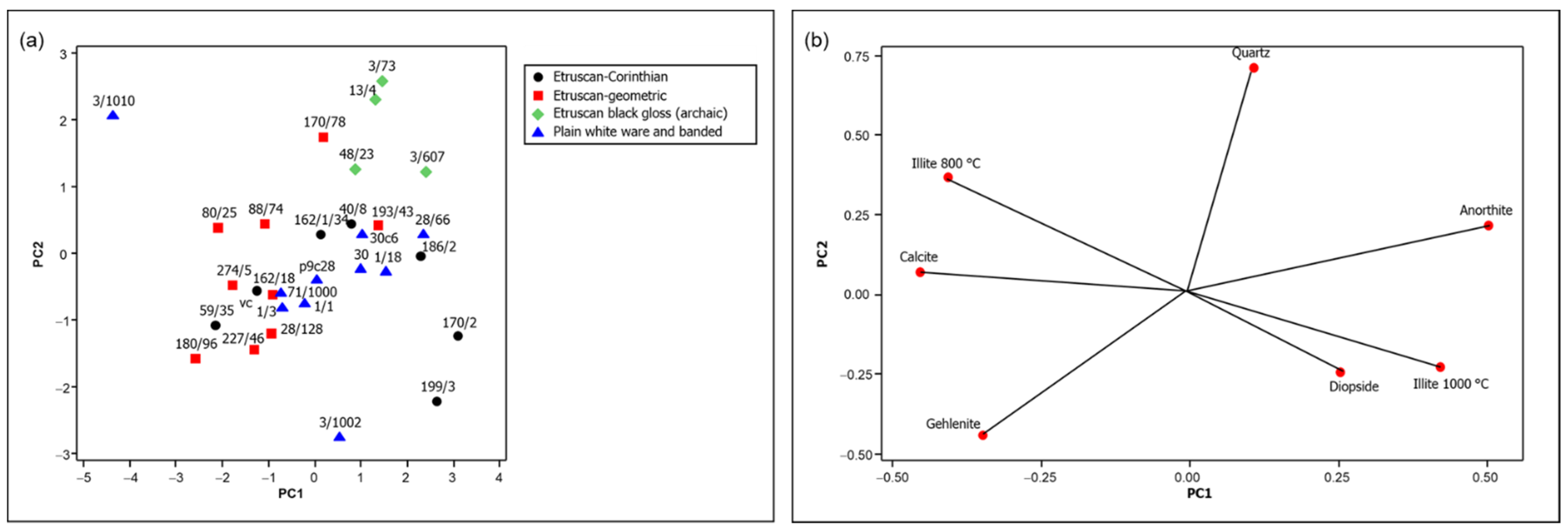

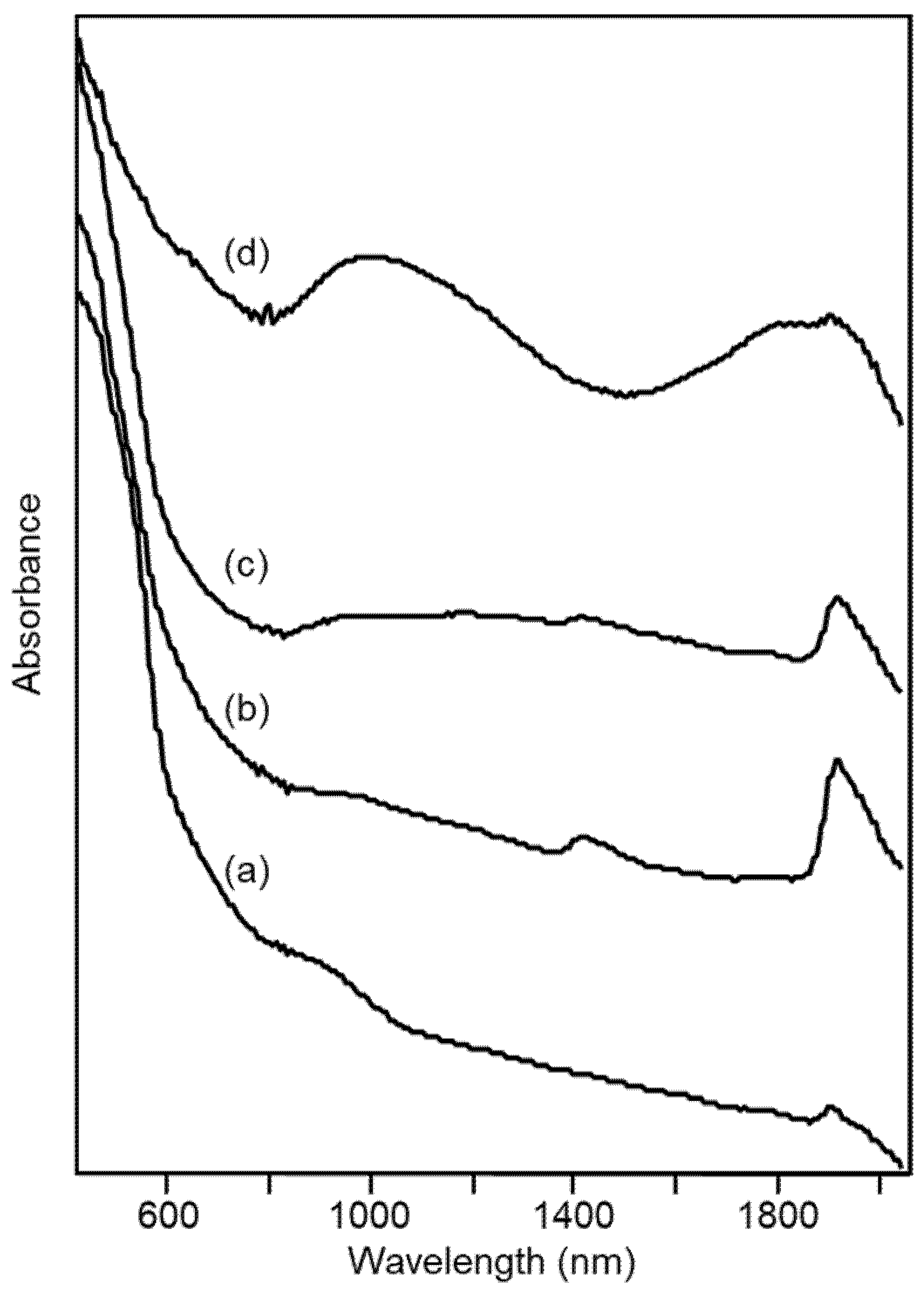
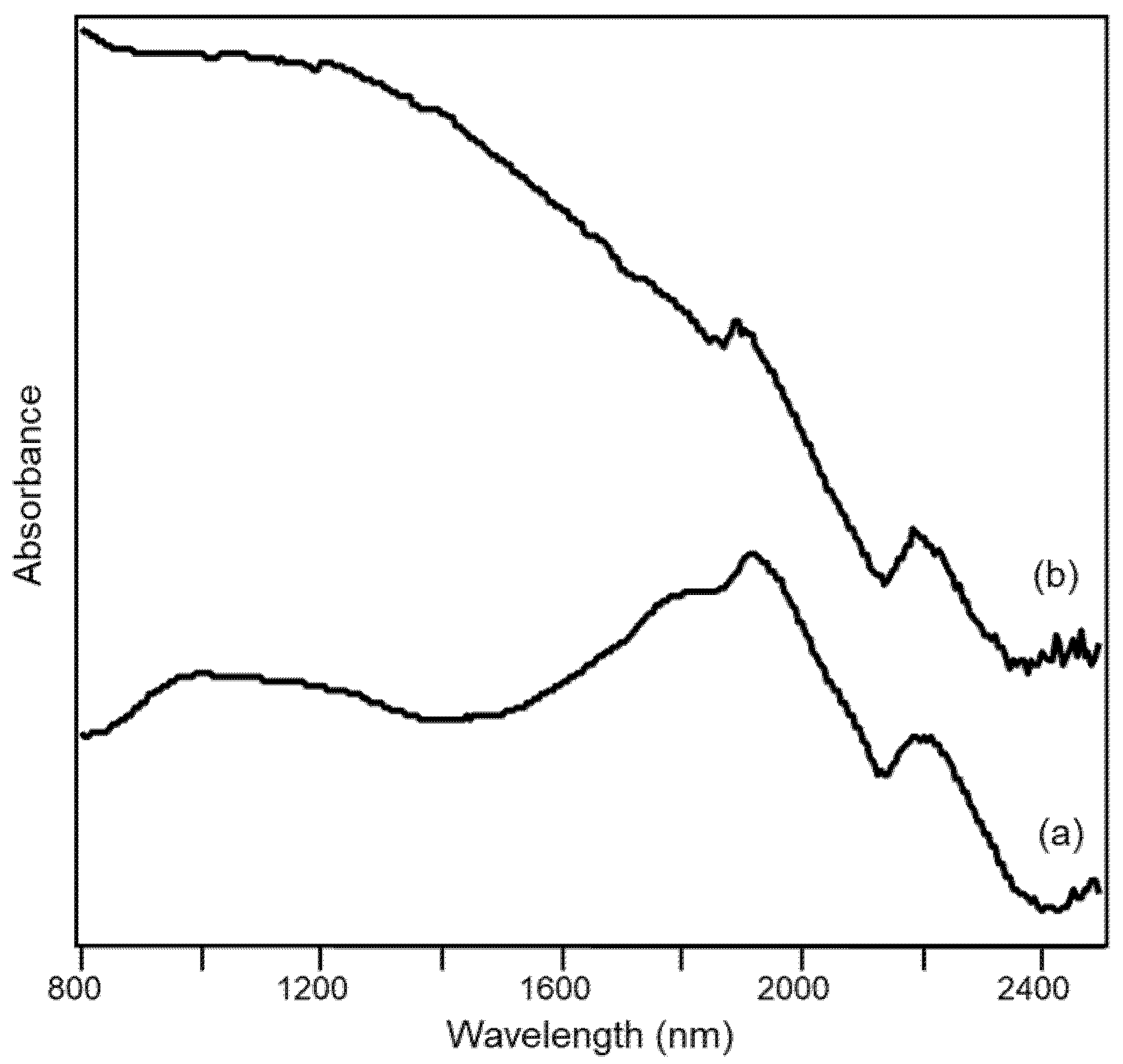
| Sample | Color | Class | Chronology (Century B.C.) |
|---|---|---|---|
| 1/1 | pale yellow 2.5Y7/4 | Plain white ware and banded | 6th |
| 1/18 | grey pink 5YR7/2 | Plain white ware and banded | 7th–6th |
| 1/3 | pale yellow 2.5Y7/4 | Plain white ware and banded | 7th–6th |
| 13/4 | pink 7.5YR7/4 | Etruscan black gloss (archaic) | 6th onwards |
| 162/1/34 | n.a. b | Etruscan-Corinthian | 7th–6th |
| 162/18 | pale yellow 2.5Y7/4 | Etruscan-geometric | 8th–7th |
| 170/2 | pink 7.5YR7/4 | Etruscan-Corinthian | 6th first half |
| 170/78 | light brown red 5YR6/4 | Etruscan-geometric | 7th |
| 180/96 | light brown red 5YR6/4 | Etruscan-geometric | 8th–7th |
| 186/2 | pink 7.5YR7/4 | Etruscan-Corinthian | 6th first half |
| 193/43 | pink 7.5YR7/4 | Etruscan-geometric | 8th–7th |
| 199/3 | n.a. | Etruscan-Corinthian | 8th–7th |
| 227/46 | pale yellow 2.5Y7/4 | Etruscan-geometric | 8th–7th |
| 274/5 | pale yellow 2.5Y7/4 | Etruscan-geometric | 8th–7th |
| 28/128 | pale yellow 2.5Y7/4 | Etruscan-geometric | 7th–6th |
| 28/66 | n.a. | Plain white ware and banded | 7th–6th |
| 3/1002 | pale yellow 2.5Y7/4 | Plain white ware and banded | 3rd–2nd |
| 3/1010 | grey pink 5YR7/2 | Plain white ware and banded | 8th–7th |
| 3/607 | grey pink 5YR7/2 | Etruscan black gloss (archaic) | 6th onwards |
| 3/610 a | dark grey 2.5Y4/0 | Etruscan black gloss (archaic) | 6th onwards |
| 3/73 | grey pink 5YR7/2 | Etruscan black gloss (archaic) | 6th onwards |
| 30c6 | pale yellow 2.5Y7/4 | Plain white ware and banded | 7th end |
| 30 | grey pink 5YR6/2 | Plain white ware and banded | 6th |
| 40/8 | grey pink 5YR7/2 | Etruscan-Corinthian | 6th first half |
| 48/23 | grey pink 5YR6/2 | Etruscan black gloss (archaic) | 6th onwards |
| 59/35 | light brown red 5YR6/4 | Etruscan-Corinthian | 6th first half |
| 71/1000 | n.a. | Plain white ware and banded | 8th–7th |
| 80/25 | light brown red 5YR6/4 | Etruscan-geometric | 8th–7th |
| 88/74 | pale yellow 2.5Y7/4 | Etruscan-geometric | 8th–7th |
| p9c28 | pink 7.5YR7/4 | Plain white ware and banded | 7th end |
| vc | n.a. | Etruscan-Corinthian | ? |
| Phase | R2 | Predicted R2 |
|---|---|---|
| anorthite | 0.97 | 0.89 |
| calcite | 1.00 | 1.00 |
| diopside | 0.98 | 0.92 |
| gehlenite | 0.95 | 0.56 |
| illite heated at 800 °C | 0.94 | 0.89 |
| illite heated at 1000 °C | 0.96 | 0.94 |
| quartz | 0.97 | 0.91 |
Publisher’s Note: MDPI stays neutral with regard to jurisdictional claims in published maps and institutional affiliations. |
© 2022 by the author. Licensee MDPI, Basel, Switzerland. This article is an open access article distributed under the terms and conditions of the Creative Commons Attribution (CC BY) license (https://creativecommons.org/licenses/by/4.0/).
Share and Cite
Bruni, S. Etruscan Fine Ware Pottery: Near-Infrared (NIR) Spectroscopy as a Tool for the Investigation of Clay Firing Temperature and Atmosphere. Minerals 2022, 12, 412. https://doi.org/10.3390/min12040412
Bruni S. Etruscan Fine Ware Pottery: Near-Infrared (NIR) Spectroscopy as a Tool for the Investigation of Clay Firing Temperature and Atmosphere. Minerals. 2022; 12(4):412. https://doi.org/10.3390/min12040412
Chicago/Turabian StyleBruni, Silvia. 2022. "Etruscan Fine Ware Pottery: Near-Infrared (NIR) Spectroscopy as a Tool for the Investigation of Clay Firing Temperature and Atmosphere" Minerals 12, no. 4: 412. https://doi.org/10.3390/min12040412
APA StyleBruni, S. (2022). Etruscan Fine Ware Pottery: Near-Infrared (NIR) Spectroscopy as a Tool for the Investigation of Clay Firing Temperature and Atmosphere. Minerals, 12(4), 412. https://doi.org/10.3390/min12040412






